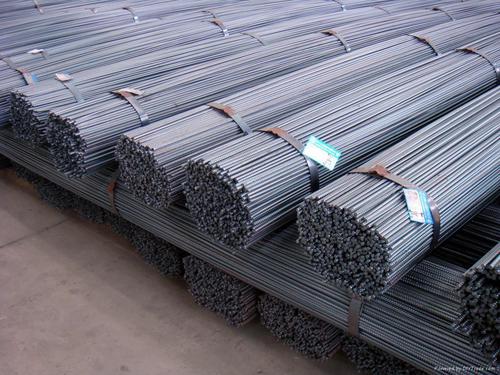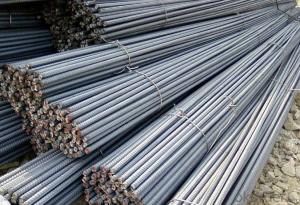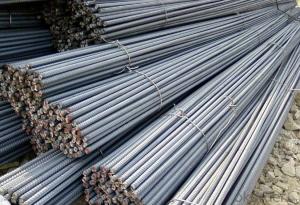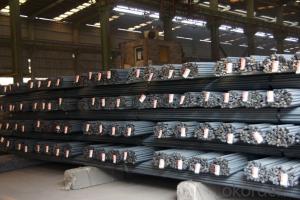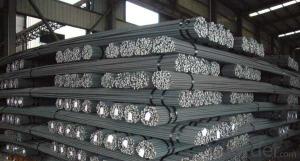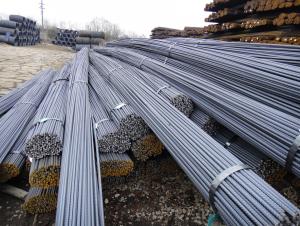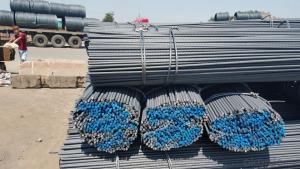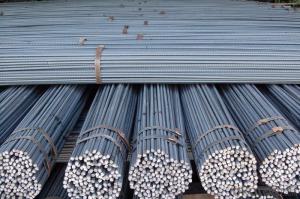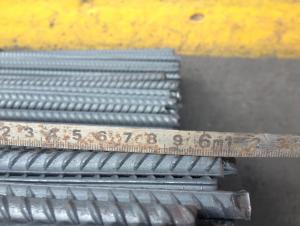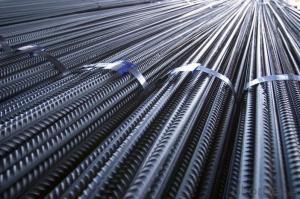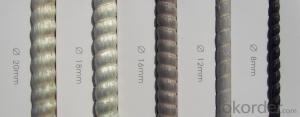Hot Rolled Rebars with High Quality and Best Price
- Loading Port:
- Tianjin
- Payment Terms:
- TT OR LC
- Min Order Qty:
- 25 m.t.
- Supply Capability:
- 10000 m.t./month
OKorder Service Pledge
OKorder Financial Service
You Might Also Like
OKorder is offering high quality Hot Rolled Rebars at great prices with worldwide shipping. Our supplier is a world-class manufacturer of steel, with our products utilized the world over. OKorder annually supplies products to European, North American and Asian markets. We provide quotations within 24 hours of receiving an inquiry and guarantee competitive prices.
Product Applications:
Deformed bar is widely used in buildings, bridges, roads and other engineering construction. Big to highways, railways, bridges, culverts, tunnels, public facilities such as flood control, dam, small to housing construction, beam, column, wall and the foundation of the plate, deformed bar is an integral structure material. With the development of world economy and the vigorous development of infrastructure construction, real estate, the demand for deformed bar will be larger and larger..
Label: to be specified by customer, generally, each bundle has 1-2 labels
Product Advantages:
OKorder's Hot Rolled Rebars are durable, strong, and resist corrosion.
Main Product Features:
· Premium quality
· Prompt delivery & seaworthy packing (30 days after receiving deposit)
· Corrosion resistance
· Can be recycled and reused
· Mill test certification
· Professional Service
· Competitive pricing
Product Specifications:
Manufacture: Hot rolled
Grade: HRB400 – HRB500
Certificates: ISO, SGS, BV, CIQ
Length: 6m – 12m, as per customer request
Packaging: Export packing, nude packing, bundled
Grade | Technical data of the original chemical composition (%) | ||||||
C | Mn | Si | S | P | V | ||
HRB400 | ≤0.25 | ≤1.60 | ≤0.80 | ≤0.045 | ≤0.045 | 0.04-0.12 | |
Physical capability | |||||||
Yield Strength (N/cm²) | Tensile Strength (N/cm²) | Elongation (%) | |||||
≥400 | ≥570 | ≥14 | |||||
Theoretical weight and section area of each diameter as below for your information:
Diameter(mm) | Section area (mm²) | Mass(kg/m) | Weight of 12m bar(kg) |
6 | 28.27 | 0.222 | 2.664 |
8 | 50.27 | 0.395 | 4.74 |
10 | 78.54 | 0.617 | 7.404 |
12 | 113.1 | 0.888 | 10.656 |
14 | 153.9 | 1.21 | 14.52 |
16 | 201.1 | 1.58 | 18.96 |
18 | 254.5 | 2.00 | 24 |
20 | 314.2 | 2.47 | 29.64 |
22 | 380.1 | 2.98 | 35.76 |
25 | 490.9 | 3.85 | 46.2 |
28 | 615.8 | 4.83 | 57.96 |
32 | 804.2 | 6.31 | 75.72 |
36 | 1018 | 7.99 | 98.88 |
40 | 1257 | 9.87 | 118.44 |
50 | 1964 | 15.42 | 185.04 |
FAQ:
Q1: Why buy Materials & Equipment from OKorder.com?
A1: All products offered byOKorder.com are carefully selected from China's most reliable manufacturing enterprises. Through its ISO certifications, OKorder.com adheres to the highest standards and a commitment to supply chain safety and customer satisfaction.
Q2: How do we guarantee the quality of our products?
A2: We have established an advanced quality management system which conducts strict quality tests at every step, from raw materials to the final product. At the same time, we provide extensive follow-up service assurances as required.
Q3: How soon can we receive the product after purchase?
A3: Within three days of placing an order, we will begin production. The specific shipping date is dependent upon international and government factors, but is typically 7 to 10 workdays.
Images:

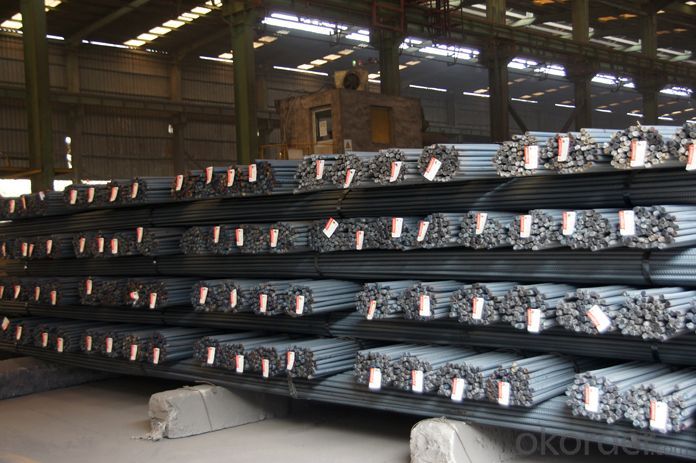
- Q: Can steel rebars be used in structures with high chloride ion concentration?
- Steel rebars should not be used in structures with high chloride ion concentration as it can lead to corrosion and structural degradation. Instead, alternative materials such as stainless steel rebars or fiber-reinforced polymers should be used to ensure durability and integrity of the structure.
- Q: What is the elongation of steel rebars?
- The elongation of steel rebars refers to the amount of deformation or stretching that a steel rebar can undergo before it fractures or breaks. It is a measure of the ductility or flexibility of the steel rebar. Elongation is typically expressed as a percentage of the original length of the rebar. The elongation of steel rebars varies depending on the grade or type of steel used and the manufacturing processes involved. Generally, steel rebars have a relatively high elongation compared to other construction materials such as concrete or timber. This makes them suitable for applications where flexibility and resistance to deformation are important, such as in reinforced concrete structures. The elongation of steel rebars is an important factor to consider in structural design and construction. It influences the ability of a rebar to withstand loads, especially in situations where the rebar is subjected to tension or bending forces. Higher elongation values indicate a greater ability of the rebar to stretch and deform without breaking, which improves the overall performance and safety of the structure. To ensure the proper selection and use of steel rebars, it is essential to consult the relevant standards and specifications provided by regulatory bodies and industry organizations. These guidelines provide specific requirements and recommendations for the elongation of steel rebars, as well as other mechanical properties, to ensure the structural integrity of construction projects.
- Q: How are steel rebars connected to each other?
- Steel rebars are typically connected to each other using various methods such as overlapping, welding, or using mechanical connectors like couplers or threaded bars.
- Q: Can steel rebars be used in the construction of swimming pools?
- Yes, steel rebars can be used in the construction of swimming pools. Steel rebars provide strength and reinforcement to the concrete structure of the pool, ensuring its durability and structural integrity. They are commonly used to reinforce the pool's walls, floor, and other structural elements.
- Q: What is the role of steel rebars in tunnel lining construction?
- The role of steel rebars in tunnel lining construction is to reinforce the concrete structure and provide added strength and durability. They help distribute the load and prevent cracks or collapses, ensuring the stability and long-term integrity of the tunnel.
- Q: How do steel rebars affect the overall crack width of concrete structures?
- Steel rebars affect the overall crack width of concrete structures in several ways. Firstly, rebars provide reinforcement to the concrete, making it stronger and more resistant to cracking. The presence of rebars helps distribute the tensile forces within the concrete, preventing cracks from spreading and widening. This is because when the concrete is subjected to tensile stress, the rebars take on a significant portion of the load, reducing the stress on the concrete itself and minimizing crack formation. Moreover, the use of rebars also influences the spacing and size of cracks in concrete structures. By adding rebars at specific intervals and in appropriate sizes, engineers can control the crack width of the concrete. The rebars act as barriers that limit the width of cracks by providing resistance to the tensile forces acting on the concrete. This is particularly important in structures that are exposed to heavy loads or external forces, as it helps maintain the structural integrity and durability of the concrete. Additionally, steel rebars can also affect the propagation of cracks in concrete structures. When cracks do occur, the presence of rebars can help prevent the cracks from extending further. The rebars act as anchors, holding the cracked sections of the concrete together and preventing the cracks from spreading. This is crucial in ensuring the overall stability of the structure and minimizing the risk of structural failure. In summary, steel rebars play a vital role in influencing the overall crack width of concrete structures. They enhance the strength of the concrete, distribute tensile forces, control crack spacing and size, and prevent crack propagation. By incorporating rebars into concrete structures, engineers can effectively manage and reduce the formation and severity of cracks, ensuring the longevity and safety of the structures.
- Q: How do steel rebars perform in heavy load-bearing structures?
- Steel rebars perform exceptionally well in heavy load-bearing structures. They offer high tensile strength, durability, and excellent resistance to corrosion. These properties enable rebars to effectively withstand heavy loads and provide structural stability, ensuring the long-term integrity of the structure.
- Q: What are the common types of coatings applied to steel rebars for corrosion protection?
- The common types of coatings applied to steel rebars for corrosion protection include epoxy coatings, zinc coatings (galvanization), and polyurethane coatings.
- Q: Can steel rebars be used in historical buildings restoration?
- Yes, steel rebars can be used in historical buildings restoration. Steel rebars provide strength and structural integrity to the building, ensuring its stability and longevity. However, it is crucial to use rebars that are compatible with the historical building's materials and design to preserve its authenticity. Additionally, proper installation techniques and preservation methods should be employed to minimize any potential damage or alteration to the historical fabric of the building.
- Q: How do steel rebars help in reducing construction time?
- Steel rebars help in reducing construction time in several ways: 1. Strength and durability: Steel rebars provide additional strength and durability to concrete structures, allowing for faster construction techniques. This means that builders can rely on the strength of rebars to support the weight of the structure, reducing the need for slower and more time-consuming construction methods. 2. Reinforcement: By reinforcing concrete with steel rebars, the overall structural integrity of the building is enhanced. This enables builders to use thinner concrete sections without compromising the strength of the structure. Thinner sections require less material and are quicker and easier to pour and cure, saving construction time. 3. Speed of installation: Steel rebars are easy to handle and install, which speeds up the construction process. They can be easily cut and bent to fit the desired shape and size, allowing for efficient installation. This eliminates the need for complex and time-consuming formwork, reducing construction time. 4. Flexibility: Steel rebars offer flexibility in design and construction, allowing for innovative and efficient building techniques. They can be used in various applications, such as beams, columns, and slabs, giving architects and engineers the freedom to design structures that can be constructed quickly and efficiently. 5. Resistance to natural disasters: Steel rebars provide added resistance to seismic activity and other natural disasters. By reinforcing concrete with rebars, structures become more resilient, reducing the risk of damage and accelerating the construction process. This is particularly important in areas prone to earthquakes or extreme weather conditions. Overall, steel rebars play a crucial role in reducing construction time by providing strength, durability, and flexibility. Their ease of installation, coupled with their ability to reinforce concrete structures, allows for faster construction methods and efficient use of materials.
Send your message to us
Hot Rolled Rebars with High Quality and Best Price
- Loading Port:
- Tianjin
- Payment Terms:
- TT OR LC
- Min Order Qty:
- 25 m.t.
- Supply Capability:
- 10000 m.t./month
OKorder Service Pledge
OKorder Financial Service
Similar products
Hot products
Hot Searches
Related keywords




